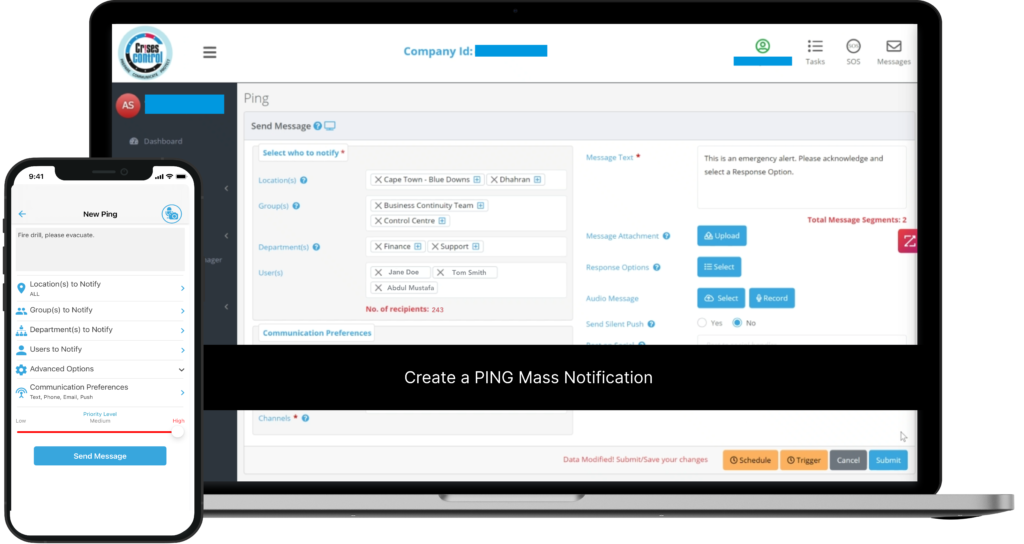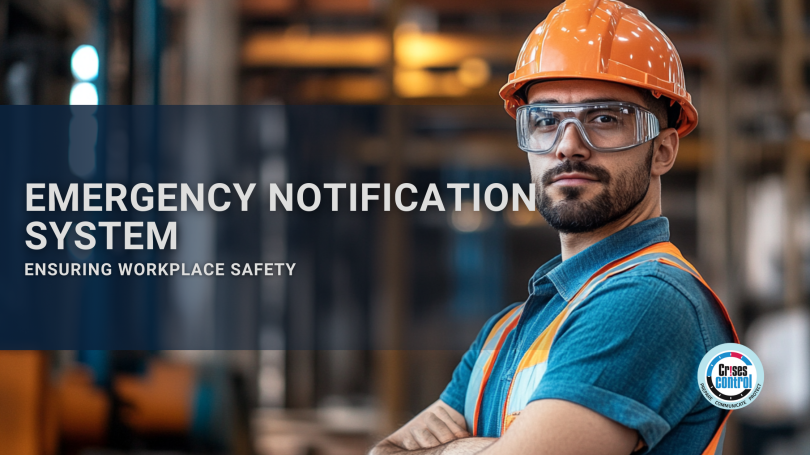Written by Anneri Fourie | Marketing Executive
In an era marked by rapid technological advancements and increasing workplace complexities, ensuring the safety of employees has become a paramount concern for organisations across all industries. From bustling urban offices to remote work settings, the need for effective safety measures has never been greater. With increasing threats—from natural disasters to workplace violence—having a robust communication strategy is essential. One of the most critical tools in any safety plan is an Emergency Notification System.
This blog explores the fundamental role of an Emergency Notification System in ensuring workplace safety and highlights how Crises Control can equip your organisation with the tools necessary to keep your employees safe.
What is an Emergency Notification System?
An Emergency Notification System is a vital communication tool designed to swiftly disseminate information during emergencies. Its primary function is to ensure that all employees receive timely alerts about critical situations that could impact their safety. This system can send messages through various channels, including text messages, emails, and mobile applications, guaranteeing that information reaches everyone, regardless of their location.
The Importance of Emergency Notification Systems
In a world where emergencies can strike without warning, a robust Emergency Notification System serves as the foundation of an organisation’s crisis management strategy. Without such preparation, organisations risk confusion and panic, which can lead to dire consequences when it matters most.
The Role of an Emergency Notification System in Ensuring Workplace Safety
1. Rapid Information Dissemination
The first and most vital role of an Emergency Notification System (ENS) is its ability to disseminate information quickly. During emergencies, every second counts. Traditional communication methods, such as emails or intercom systems, may not be sufficient to reach employees in a timely manner. An effective ENS can send alerts within seconds, ensuring that critical information is communicated immediately.
For example, imagine a severe weather event approaching your location. With an ENS, you can alert employees to evacuate or seek shelter well before the threat arrives, giving them valuable time to act. This rapid response can save lives and minimise injuries.
2. Multi-Channel Communication
A robust Emergency Notification System utilises multi-channel communication to ensure that messages reach all employees. This approach is essential for organisations with a diverse workforce, including those working remotely or across multiple locations. The ability to send alerts via SMS, email, and mobile applications ensures that everyone receives the message, regardless of their preferred communication method.
Moreover, these systems can also leverage social media channels to reach a wider audience. For instance, if there’s a serious incident, posting updates on platforms like Twitter can help disseminate critical information not only internally, but also externally, when necessary.
3. Real-Time Updates During Emergencies
During a crisis, conditions can change rapidly. An effective Emergency Notification System provides real-time updates to keep employees informed about evolving situations. This capability is vital in scenarios where initial alerts may need to be adjusted as more information becomes available.
For instance, if a fire alarm is triggered, the ENS can send immediate alerts to evacuate the building. As the situation unfolds, the system can provide updates on the status of the emergency, informing employees when it is safe to return or if they need to relocate to a different area.
Interested in our Ping Emergency Notification System?
Efficiently alert everyone in seconds at scale with our Emergency Notification System – PING, get the message out fast and ensure rapid response and recovery.

Enhancing Preparedness with an Emergency Notification System
1. Proactive Measures and Training
Preparation is key to effective crisis management. An Emergency Notification System is not only a tool for responding to emergencies, but also a vital component of a proactive safety strategy. By providing training and resources, organisations can prepare employees for various emergency scenarios.
Crises Control offers comprehensive training programmes that help employees understand how to respond in emergencies. Familiarising them with the ENS and its capabilities ensures that everyone knows what to do when an alert is received. For example, role-playing different emergency situations during training can help employees feel more confident and prepared.
2. Conducting Drills and Testing
Regularly testing the Emergency Notification System is crucial for ensuring its effectiveness. Conducting drills allows organisations to assess their response plans and identify areas for improvement. Crises Control supports organisations in creating realistic drill scenarios that test not only the ENS, but also the overall emergency response strategy.
Through these exercises, employees can practise their responses, ensuring they are prepared when a real emergency occurs. This hands-on experience builds confidence and familiarity with the system, making it easier to react decisively during a crisis.
Building a Culture of Safety
1. Fostering Trust and Engagement
Implementing an Emergency Notification System is not just about technology; it’s also about building a culture of safety within the organisation. When employees know that their safety is a priority, it fosters trust and engagement. An ENS provides reassurance that the organisation is prepared to respond effectively in emergencies.
Crises Control emphasises the importance of involving employees in the safety planning process. By encouraging feedback and input on emergency procedures, organisations can create a sense of ownership among employees, enhancing their commitment to safety. For instance, hosting regular safety meetings where employees can voice their concerns or suggestions can significantly improve the overall safety culture.
2. Encouraging Employee Involvement
An effective Emergency Notification System empowers employees to take an active role in workplace safety. Training sessions and drills should encourage employees to ask questions and provide feedback on the procedures. This engagement can lead to valuable insights and improvements in the safety plan.
Moreover, organisations can establish a safety committee that includes representatives from various departments. This committee can play a vital role in promoting safety initiatives and ensuring that the Emergency Notification System is utilised effectively across the organisation.
Key Features of an Effective Emergency Notification System
When selecting an Emergency Notification System, organisations should consider several key features to ensure it meets their needs:
1. Integration Capabilities
An effective Emergency Notification System should seamlessly integrate with existing communication platforms and safety tools. This integration ensures that alerts can be sent out quickly and efficiently without requiring manual intervention. Crises Control offers an ENS that can integrate with various software systems, enhancing its utility in real-time crisis management.
2. Customisable Alerts and Notifications
The ability to customise alerts is essential for ensuring that messages are relevant to specific situations. Organisations should look for systems that allow them to tailor their notifications based on the type of emergency and the audience. Crises Control enables organisations to create tailored messaging for different scenarios, ensuring that employees receive the most pertinent information.
3. Analytics and Reporting
Post-incident analysis is crucial for improving emergency response strategies. An Emergency Notification System should provide analytics and reporting features to help organisations assess their response efforts. Crises Control’s ENS offers comprehensive reporting tools that allow organisations to evaluate the effectiveness of their alerts and identify areas for improvement.
How Crises Control Can Help
Crises Control is committed to providing organisations with the tools they need to enhance workplace safety through effective emergency communication. Here’s how we can support your organisation:
1. Comprehensive ENS Solutions
Crises Control offers a robust Emergency Notification System designed to meet the needs of diverse organisations. With features such as multi-channel alerts, easy integration, and a user-friendly interface, our system empowers organisations to communicate effectively during emergencies.
2. Real-Life Success Stories
Many organisations have successfully implemented Crises Control’s Emergency Notification System, leading to improved safety outcomes. For instance, one organisation reported a significant reduction in response times during emergencies after adopting our system, demonstrating the tangible benefits of effective emergency communication.
3. Ongoing Support and Training
Crises Control provides continuous support and training to ensure that organisations can maximise the benefits of their Emergency Notification System. Our team offers tailored training sessions and resources to help employees understand how to use the system effectively.
4. Future-Proofing Workplace Safety
As technology evolves, so do the threats organisations face. Crises Control is dedicated to staying at the forefront of innovation in emergency communication. We continuously update our systems to incorporate the latest advancements, ensuring that your organisation is always equipped to handle emerging challenges.
Conclusion
In conclusion, an Emergency Notification System is essential for ensuring workplace safety in today’s dynamic environment. By enabling rapid communication, enhancing preparedness, and fostering a culture of safety, organisations can significantly improve their response to emergencies. Crises Control offers comprehensive solutions to help organisations implement an effective Emergency Notification System that meets their unique needs.
Don’t wait until it’s too late. Contact us today to get a free demo and see how Crises Control can help you stay prepared and keep your workplace safe.
Request a FREE Demo

